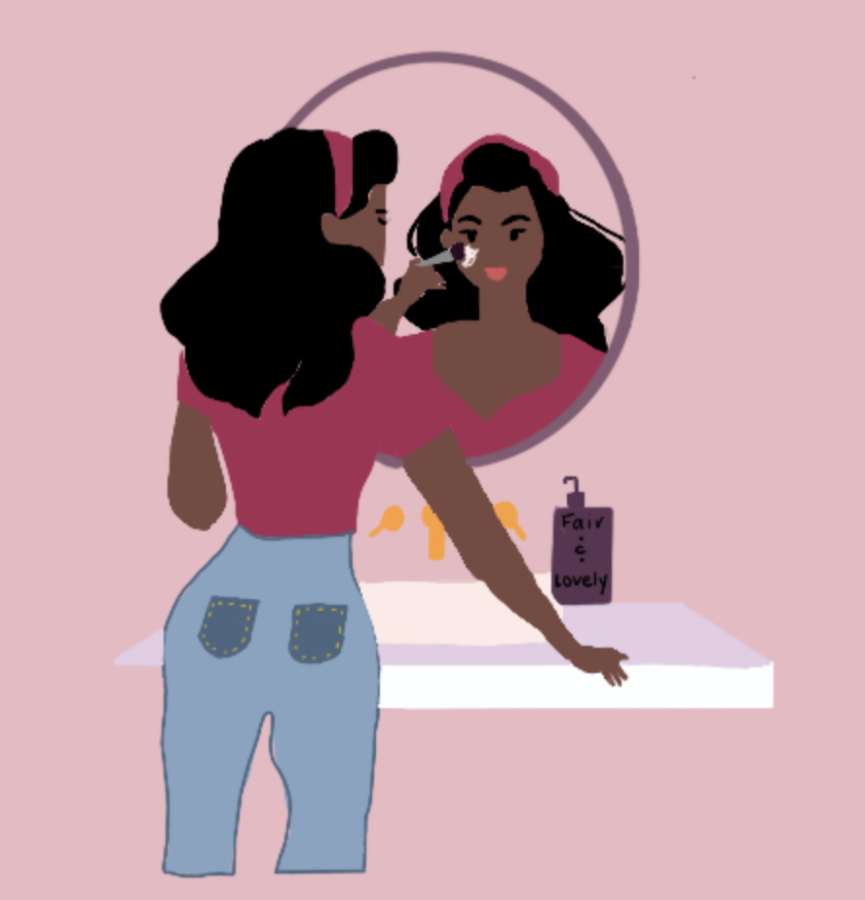Toxicity in Asian-American Standards: South-Asian Underrepresentation
Toxic Asian-beauty standards have made many South Asians use face-whitening products like Fair and Lovely to have a more Eurocentric look.
From the brutal killing of George Floyd to the shooting targeted towards Sikh South Asians, the word “race” has been prevalent on the news. The word “race” is seen as a detrimental social construct denoted to target various ethnic and minority groups. In the 21st century, racialization has continued to grow, impacting people’s ethnic identities, especially South Asians.
The Indian diaspora in the Asian-American community has created long-term societal underrepresentation due to rising stereotypes dealing with colorism and racial profiling; therefore, society can use social alliances to educate the community and embrace diversity to strive to change the racialization embedded in today’s culture.
South Asians, specifically Indians, immigrated to South Africa and North America in the 1700s, where they experienced xenophobia, which is prejudice against foreigners. Due to the economic threats South Asians posed, xenophobia targeted mostly Indian immigrants. Many ‘superior’ light-skinned, “American” individuals establish discriminatory laws to disenfranchise and isolate Indian immigrants.
The term “Asian-American” is used as an inclusive term to unify the range of communities in the Asian-American spectrum, but it falls short with South Asians. Many South Asians’ identities are made up of their ethnic and racial makeups; however, the bigotry and erasure discriminates against their true identities, according to TIME journalist Anna Purna Kambhampaty.
“A 2016 study done by the National Asian American Survey found that 42% of white Americans believed that Indians are ‘not likely to be’ Asian or Asian American, with 45% believing that Pakistanis ‘not likely to be’ Asian or Asian American,” Kambhampaty said in her article “At Census Time, Asian Americans Again Confront the Question of Who ‘Counts’ as Asian. Here’s How the Answer Got So Complicated.” “15% reporting that Indians are ‘not likely to be’ either. ‘The question of Asian American identity is contested, with South Asian groups (Indians and Pakistanis) finding it more challenging for American society to view them as Asian American,’ concluded the researchers.”
Excluding and racially profiling Indians from the Asian-American spectrum deprives them of gaining a sense of worth and agency in society. These selective narratives of Asian-Americans exclude certain ethnic identities and draw an incomplete portrait.
The Asian-American spectrum restriction plays a crucial role in understanding how Indians are not seen as Asian-Americans due to stereotypical ideologies of society’s narrow mindsets. The selectivity for Indians creates an incomplete sector of Asian-Americans, which is due to the racial misunderstandings and failure of representing Indians as Asian-Americans, as seen through stereotypical beauty standards.
Beauty standards have developed a reputation for their romanticized representation of true beauty, which is a cultivation of color and race discrimination. From Fair and Lovely to Patanjali Moisturizer, India’s skincare brands have made the promise to ‘whiten’ dark-skinned individuals.
Beauty standards have romanticized the “bright” individuals, since they outshine the “dark” and “dirty.” Therefore, South Asians need to conform to society’s beauty standards shows the rise in colorism in the South Asian communities.
The relevance of colorism in Asian-American beauty has caused Indians to crave the desirable complexion of whiteness. The exploitation of unreasonable promises created by beauty products in India is spurred by the Eurocentric beauty standards that cause South Asians to feel insecure due to the stagnant beauty standards, which ultimately causes xenophobia.
However, arguments persist that Indians are equally represented in the Asian-American community as they are the dominant ethnic group on the spectrum.
“Indian Americans were the largest Asian origin group in 22 states, including Illinois. They accounted for 31% of the state’s Asian population, followed by Filipinos and Chinese with each comprising about 19%,” WBEZ Chicago writer Esther Yoon-Ji Kang said. “It’s important to remember that the Asian American community is diverse.”
The impact of South Asia’s booming, diverse culture, including its dialect, food and values, drives the vibrancy in America. Their success and a melting pot of diversity adds to the overall reason for the rise of their population and cultural dominance, allowing South Asians, specifically Indians, to feel included in the thriving Asian-American culture.
Yet, the ideology of equal representation of South Asians in the Asian-American spectrum is an inaccurate portrayal.
“The ‘Asian American pan ethnicity’ [is] a way to talk about the many differences amongst this larger category we would call Asian American,” assistant professor of Asian-American studies at the University of California, Irvine Isabela Seong-Leong Quintana said. “But we also acknowledged that there are hierarchies of color and citizenship status that South Asians sometimes are identified by outside of this political community and are identified as Middle Eastern, sometimes, or racialized and mistaken for Latinos.”
Quintana emphasizes this historical impact of the migration of South Asians, specifically the 1965 Immigration Act, which eliminated the national origins quota system allowing more individuals to immigrate, including many South Asians.
The “brownness” of Indian’s skin allows them to take on a role as Middle Eastern or Latino, but not as Asian-American. The embedded colorism has caused many South Asians to impersonate other people’s ethnic identities, according to Quintana, and its prevalent effects build social hierarchies to deem superiority among others within the same ethnic group.
To reform the oppressive beliefs of colorism and racialization toward South Asians, people need to embrace diversity and reestablish the commitment to racial justice by fostering alliances, such as the Asian American Alliance or the Southeast Asian Alliance. Implementing these social, cultural and political alliances mobilizes and empowers Asian-Americans for a mutual cause where they can express their ethnic identities.
Your donation will support the student journalists of Portola High School. Your contribution will allow us to purchase equipment and cover our annual website hosting costs.

Arshia Sista is this year’s front page editor for her second and last year on the Portola Pilot. She’s both bittersweet and excited to design quirky...




